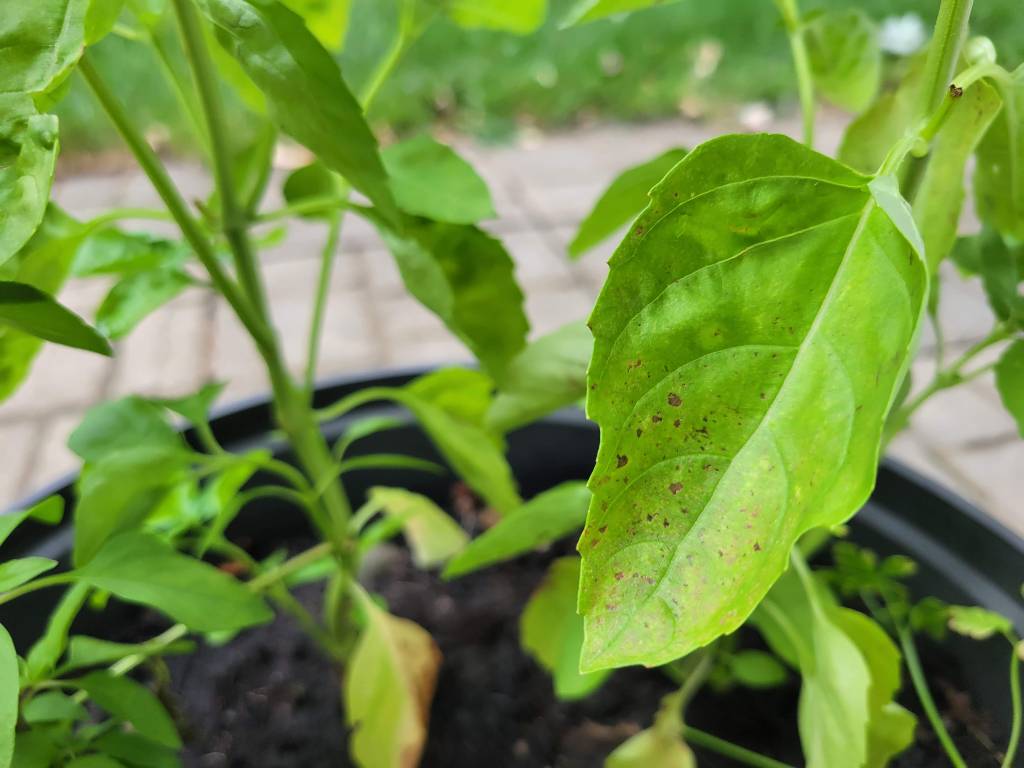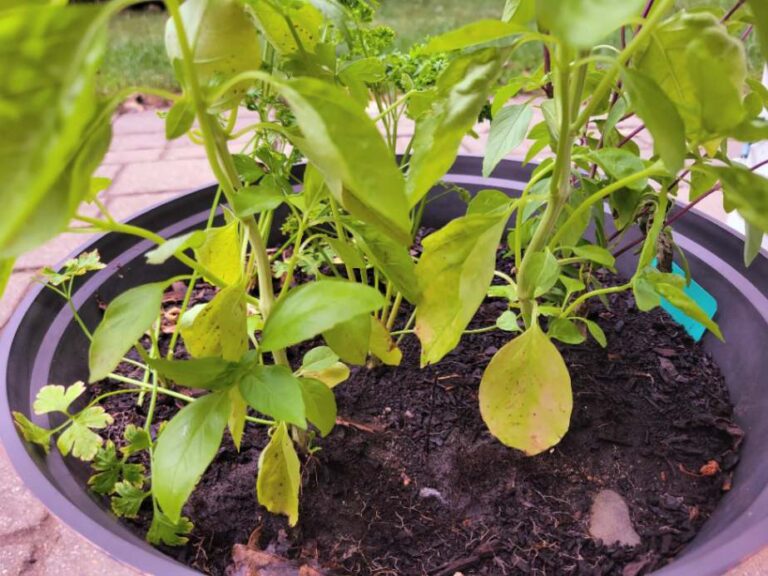This post may contain affiliate links which means I may receive a commission for purchases made through links. I only recommend products that I have personally used. As an Amazon Associate I earn from qualifying purchases. Learn more on my Private Policy page.
Yellowing leaves in basil can be caused by various factors such as nutrient deficiencies, overwatering, pests like caterpillars, or even root problems. By identifying and addressing these issues early on, you can save your potted basil from wilting away. After all, who wouldn’t want to enjoy the aromatic flavors of fresh basil in their garden or kitchen?

Causes of Yellow Basil Leaves
Why Do I Have Yellow Basil Leaves? Yellowing of basil leaves can be caused by a variety of factors, including disease, nutrient deficiencies, over-fertilization, overwatering, inadequate soil aeration, or improper temperature and light.
1) Diseases: Basil plants are susceptible to several diseases that can cause yellowing of their leaves. One such disease is downy mildew, which manifests as yellow spots on the upper surface of the leaves and a fuzzy gray or purple growth underneath. Fusarium wilt is another disease that affects basil plants, causing yellowing and wilting of leaves. To prevent the spread of these diseases, it is essential to remove infected plants promptly and avoid overcrowding.
2) Nutrient deficiencies: Like any other plant, basil requires a balanced supply of nutrients for optimal growth. When certain essential nutrients are lacking in the soil, it can result in yellow basil leaves. Nitrogen deficiency often leads to overall yellowing and stunted growth. Similarly, insufficient iron can cause interveinal chlorosis – a condition where the veins remain green while the areas between them turn yellow. To address nutrient deficiencies, fertilizers specifically formulated for herbs can be used or organic compost can be added to enrich the soil.
3) Over-fertilization: While providing adequate nutrients is important for basil plants’ health, excessive fertilization can have adverse effects. Over-fertilizing with nitrogen-rich fertilizers may lead to an imbalance in nutrient uptake and subsequent leaf yellowing. It is crucial to follow recommended dosage instructions when applying fertilizers and ensure proper watering afterward to prevent nutrient burn.
4) Overwatering: Basil plants prefer well-drained soil rather than being constantly soaked in water. Overwatering can hinder root development by depriving them of oxygen and lead to root rot or fungal infections like Pythium root rot. As a result, affected plants may exhibit symptoms such as wilted appearance and yellowing leaves. To avoid overwatering, it is important to allow the soil to dry out slightly between watering sessions.
5) Inadequate Soil Aeration can harm plants, including basil. To improve aeration, amend compacted soil with organic matter like compost. Earthworms also help by creating burrows that enhance drainage and aeration. Encourage earthworms by adding organic mulch, avoiding pesticides, and providing a suitable habitat. This promotes healthy basil growth.
6) Improper Temperature and Light: Extreme temperatures or inadequate light can cause yellow basil leaves. Basil prefers warm conditions but may suffer from heat stress in excessively hot climates. Providing sufficient sunlight or using grow lights helps maintain healthy foliage color. To prevent yellowing due to inadequate light, ensure basil plants receive 6-8 hours of direct sunlight daily.
Table of Contents
Dealing with Downy Mildew Disease in Basil Plants:
Downy mildew is a common fungal disease that affects various plants, including basil. It is caused by the pathogen Peronospora belbahrii and can lead to significant damage if left untreated.
Downy mildew disease definition and characteristics
Downy mildew is a highly contagious fungal infection that thrives in humid conditions. The pathogen spreads through spores that are easily carried by wind or water droplets. Once these spores come into contact with susceptible plants, they germinate and infect the host tissue.
The primary characteristic of downy mildew is the appearance of yellow basil leaves with dark green veins. As the infection progresses, a fuzzy gray or purple growth may develop on the undersides of the leaves. This growth consists of millions of spores ready to spread to neighboring plants.
Downy mildew symptoms and impact on basil
When downy mildew strikes basil plants, it can have severe consequences for their overall health and productivity. The symptoms include:
- Yellow basil leaves: The most apparent sign of downy mildew is the yellowing of basil leaves along with distinct green veins. This discoloration occurs due to nutrient deficiencies caused by the pathogen’s invasion.
- Fuzzy growth on leaf undersides: As mentioned earlier, a fuzzy gray or purple growth appears on the undersides of infected leaves. This growth contains spores that help perpetuate the disease cycle.
- Leaf curling and distortion: Infected basil leaves may exhibit curling or distortion as a result of cell damage caused by the fungus.
- Reduced plant vigor: Downy mildew weakens basil plants over time, leading to stunted growth, decreased yields, and even plant death in severe cases.
Proper ventilation and spacing between plants can help prevent its spread.
Preventing the spread of downy mildew requires implementing appropriate measures. Adequate ventilation and proper spacing between plants are essential to reduce humidity levels and minimize the risk of infection. Here’s what you can do:
- Provide ample space: Ensure that basil plants have enough room for air circulation by maintaining a recommended distance of at least 12 inches between each plant.
- Promote good airflow: Position your basil plants in an area with sufficient air movement, such as near a fan or in an open space. This will help prevent moisture buildup and create an unfavorable environment for downy mildew development.
- Avoid overhead watering: Watering from above can increase humidity levels, creating favorable conditions for downy mildew. Instead, opt for drip irrigation or water at the base of the plant to keep foliage dry.
Fungicides specifically formulated for downy mildew may be necessary for control.
In some cases, preventive measures may not suffice, and the use of fungicides becomes necessary to control downy mildew disease effectively. When selecting a fungicide, it is crucial to choose one specifically formulated for combating downy mildew. Some common options include:
- Copper-based fungicides: These products provide effective control against downy mildew when applied according to label instructions. Copper ions disrupt fungal cell membranes, inhibiting their growth and spread.
Nutrient Deficiency: Blackish Spots on Basil Plants
Basil plants require essential nutrients to thrive and maintain their vibrant green color. However, when you notice blackish spots appearing on the leaves of your basil plant, it could be an indication of a nutrient deficiency. Understanding the importance of these nutrients and how they affect the health of your basil plants is crucial in addressing this issue effectively.

One possible cause for blackish spots on basil leaves is a lack of certain essential nutrients like iron or magnesium. These nutrients play vital roles in various metabolic processes within the plant, including chlorophyll production and enzyme activation. Without sufficient amounts of these nutrients, the basil leaves may start to show signs of discoloration.
To address this nutrient deficiency and restore the health of your basil plants, there are several steps you can take:
Identify the deficient nutrient
Firstly, you need to determine which specific nutrient is lacking in your basil plants. This can be done through visual inspection or by conducting soil tests to analyze its composition. Identifying the deficient nutrient will help you tailor your approach in rectifying the issue.
Adjust fertilizer application
Once you have identified the deficient nutrient, adjusting your fertilizer application can provide a quick solution. Choose a fertilizer that is rich in the specific nutrient required by your basil plants and apply it according to the instructions provided. This will help replenish the missing nutrients and promote healthy growth.
Use nutrient-rich soil
Another effective method to address nutrient deficiencies is by using nutrient-rich soil or compost when planting or transplanting basil seedlings. Nutrient-dense soil provides a steady supply of essential elements required for optimal growth and development.
Monitor watering practices
Proper watering techniques are also crucial in preventing and managing nutrient deficiencies in basil plants. Overwatering can lead to leaching of important nutrients from the soil, while underwatering can hinder nutrient uptake. It is essential to maintain a balanced watering schedule to ensure the plants receive an adequate supply of nutrients.
Consider foliar feeding
In some cases, foliar feeding can be beneficial in providing a quick boost of nutrients directly to the basil leaves. This involves spraying a nutrient-rich solution onto the foliage, allowing for efficient absorption through the stomata. However, it’s important to follow proper dilution ratios and application guidelines to avoid leaf burn or damage.
By addressing nutrient deficiencies promptly and implementing appropriate measures, you can help restore your basil plants’ health and prevent further discoloration. Regular monitoring of nutrient levels and proactive care will ensure that your basil plants thrive, producing vibrant green leaves that are free from blackish spots.
Remember, healthy basil plants not only enhance the visual appeal of your garden but also provide aromatic flavors for culinary delights. So take action today to give your yellowing basil leaves the nourishment they need!
Issues with Over-Fertilization
Excessive fertilizer usage can result in yellow of basil leaves. When gardeners use too much fertilizer, it can lead to nutrient imbalances that affect the overall health of the plant. This issue arises when gardeners are not following recommended fertilization guidelines.
Over-fertilization is a common mistake that many gardeners make. They may believe that using more fertilizer will promote better growth and healthier plants. However, this excess of nutrients can actually harm the basil plants rather than help them.
One problem caused by over-fertilization is an imbalance in nitrogen levels. Nitrogen is an essential nutrient for plant growth, but too much of it can cause leaf yellowing. The excessive nitrogen interferes with other important nutrients like phosphorus and potassium, leading to deficiencies and affecting the overall health of the plant.
High pH levels resulting from excess fertilizer can also contribute to yellowing leaves. Basil prefers slightly acidic soil conditions, and when the pH becomes too high due to over-fertilizing, it hinders nutrient uptake by the roots. As a consequence, the entire plant suffers from nutrient deficiencies, and one visible symptom is yellow basil leaves.
Pests such as aphids are another issue that arises from over-fertilizing basil plants. The excessive release of nitrogen-rich fertilizers attracts aphids and other pests to feed on the plants. These pests not only damage the leaves but also introduce diseases that further weaken the basil plant’s health.
To avoid these issues associated with over-fertilization, it is crucial for gardeners to follow recommended fertilization guidelines. Instead of applying too much fertilizer at once, it is advisable to use slow-release fertilizers or organic alternatives that provide a steady supply of nutrients over time without overwhelming the plants.
Furthermore, incorporating resistant varieties into your basil garden can help mitigate problems caused by excessive fertilizing. Resistant varieties have been specifically bred to withstand certain diseases and pests, making them less susceptible to damage even if over-fertilization occurs.
Overwatering: Adjusting Watering Routine
Overwatered basil plants often exhibit yellow leaves due to root rot or suffocation. This is a common problem faced by both experienced gardeners and beginners alike. To prevent this issue, it is essential to adjust your watering routine and ensure that your yellow basil leaves regain their vibrant green color.
One of the key steps in preventing overwatering is allowing the soil to dry out between waterings. Basil plants prefer slightly dry conditions, so it’s important not to keep the soil constantly moist. By giving the soil time to dry out, you can avoid suffocating the roots and promote healthy growth.
When watering your basil plant, it is advisable to water at the base rather than overhead. Overhead watering can lead to excessive moisture on the leaves, which can create an environment conducive to fungal diseases. By directing water directly at the base of the plant, you minimize moisture-related problems and reduce the risk of yellow basil leaves caused by overwatering.
If you are growing basil indoors in pots, there are a few additional considerations for managing overwatering issues. First, ensure that your pots have proper drainage holes at the bottom. This allows excess water to escape and prevents water from accumulating around the roots. Consider using a well-draining potting mix specifically formulated for indoor plants.
Late summer is a critical time. As temperatures rise during this season, evaporation rates increase, leading to faster drying of soil. Therefore, you may need to adjust your watering frequency accordingly. Monitor the moisture level of the soil regularly by inserting your finger about an inch deep into it. If it feels dry at that depth, it’s time to water again.
Remember that overwatering is not an easy fix; prevention is key here. Once root rot sets in or suffocation occurs due to excessive moisture levels in the soil, it becomes challenging to revive the plant. Therefore, it’s crucial to be proactive in managing watering practices to avoid yellow basil leaves.
| Causes of Yellow Basil Leaves | Symptoms | Prevention and Management |
|---|---|---|
| Downy Mildew Disease | -Yellow leaves with green veins – Fuzzy gray or purple growth on underside of leaves – Leaf curling | – Provide ample space between plants – Promote good airflow – Avoid overhead watering |
| Nutrient Deficiencies | Overall yellowing and stunted growth | – Use nutrient-rich soil or compost – Fertilize with herb-specific fertilizers – Adjust watering practices |
| Over-Fertilization | – Imbalance in nitrogen levels – High pH levels – Attracts pests like aphids | – Follow recommended fertilization guidelines – Use slow-release or organic fertilizers – Incorporate resistant varieties – Monitor nutrient levels |
| Overwatering | – Root rot and fungal infections – Wilting appearance – Yellowing leaves | – Allow soil to dry out between waterings – Water at the base, avoid overhead watering – Ensure proper drainage – Adjust watering frequency |
| Soil Ecosystem and Inadequate Soil Aeration | – Poor root function and nutrient deficiencies – Soil compaction | – Amend soil with organic matter – Encourage earthworm activity – Add organic mulch or compost – Avoid chemical pesticides |
| Impact of Temperature and Light | – Heat stress and water loss – Exposure to extreme temperatures – Insufficient light and reduced chlorophyll production | – Provide sufficient sunlight (6-8 hours per day) – Avoid excessive heat or cold |
Soil Ecosystem and Inadequate Soil Aeration
Poor soil aeration can have detrimental effects on the overall health of plants, including yellow basil leaves. When the soil lacks enough air circulation and drainage, it hampers root function, leading to nutrient deficiencies and other issues. However, there are several ways to address this problem and ensure your basil plants thrive.
Amending compacted soil with organic matter improves drainage and aeration
One effective method to enhance soil aeration is by amending compacted soil with organic matter such as compost. Compacted soil tends to have poor drainage, which restricts the movement of air within the ground. By incorporating organic matter into the soil, you can improve its structure, allowing for better water infiltration and increased pore spaces for air circulation.
Organic matter acts as a sponge-like material that helps retain moisture while also preventing excessive waterlogging. This balance is crucial for basil plants as they require enough moisture without being constantly saturated. When the roots have access to enough oxygen through well-aerated soil, they can efficiently absorb nutrients from the surrounding environment, resulting in healthier foliage.
Earthworms play a vital role in maintaining a healthy soil ecosystem
Earthworms are nature’s underground engineers and play an essential role in maintaining a healthy soil ecosystem. These remarkable creatures create burrows as they tunnel through the ground, effectively improving both drainage and aeration. Their activities promote natural channels for air movement and water percolation within the soil.
Earthworms break down organic matter present in the soil through their feeding habits. As they consume decaying plant material like fallen leaves or dead roots, they help increase nutrient availability for plants while enhancing overall soil fertility. The castings produced by earthworms contain beneficial microorganisms that further aid in nutrient cycling.
To encourage earthworm activity in your garden or potted basil plants:
- Add organic mulch or compost to the soil surface: This provides a food source for earthworms and encourages their presence.
- Avoid using chemical pesticides: These can harm earthworm populations and disrupt the natural balance of the soil ecosystem.
- Create a suitable habitat: Ensure your garden has sufficient organic matter, moisture, and shelter for earthworms to thrive.
By promoting earthworm activity, you can effectively improve soil aeration and create an environment conducive to healthy basil growth.
Impact of Temperature and Light on Basil Leaves
Extreme temperatures or inadequate light can cause yellowing of basil leaves. Basil prefers warm conditions but may suffer from heat stress in excessively hot climates. Providing sufficient sunlight or using grow lights helps maintain healthy foliage color.
Yellowing of basil leaves is a common issue that many gardeners face. It can be frustrating to see your once vibrant green basil plants turn yellow and limp. However, understanding the impact of temperature and light on basil leaves can help you prevent this problem and keep your plants thriving.
Extreme temperatures or inadequate light
Basil plants are sensitive to extreme temperatures, both hot and cold. While they prefer warm conditions, excessive heat can cause stress and lead to yellowing of the leaves. On the other hand, exposure to cold temperatures can also damage the foliage.
In addition to temperature, inadequate light is another factor that contributes to yellowing of basil leaves. Basil requires at least 6-8 hours of direct sunlight each day to thrive. Insufficient light hampers photosynthesis, the process through which plants convert sunlight into energy, leading to reduced chlorophyll production and ultimately resulting in yellowing leaves.
Basil prefers warm conditions but may suffer from heat stress
Basil is a tropical herb that thrives in warm weather conditions. It grows best when temperatures range between 70°F (21°C) and 90°F (32°C). However, in regions with scorching summers or high humidity levels, basil may experience heat stress.
When exposed to extreme heat for prolonged periods, basil plants struggle to regulate their internal moisture levels effectively. This leads to water loss through transpiration at a faster rate than it can be replaced by roots’ uptake from the soil. Consequently, the plant’s ability to produce chlorophyll declines, causing the leaves to turn yellow.
Providing sufficient sunlight or using grow lights helps maintain healthy foliage color
To prevent yellowing of basil leaves due to inadequate light, it is essential to provide them with sufficient sunlight. Place your basil plants in a location where they can receive at least 6-8 hours of direct sunlight each day. If you don’t have access to a sunny spot or live in an area with limited natural light, you can use grow lights.
Grow lights are artificial lighting systems designed to mimic the sun’s spectrum and provide plants with the necessary light for photosynthesis. LED grow lights are particularly effective for indoor herb gardens as they consume less energy and emit less heat compared to traditional fluorescent bulbs. Position the grow lights about 12-18 inches above the basil plants and keep them on for 12-14 hours per day.
Managing Yellow Basil Leaves
Regularly inspecting plants for signs of yellowing is essential for early intervention. Yellow leaves can be a sign of various issues that need attention. By closely monitoring the foliage, you can identify the cause behind the yellowish basil leaves and take prompt action to manage them effectively.
Taking prompt action based on the specific cause helps manage yellow basil leaves effectively. If you notice only a few yellow leaves scattered throughout the plant, it could be due to natural aging or environmental stress. However, if the majority of the leaves are turning yellow, it indicates a more serious problem. In such cases, it is recommended to consult with master gardener volunteers or extension master gardener volunteers who have expertise in plant health and diseases.
Maintaining optimal growing conditions promotes overall plant health and prevents discoloration. Basil thrives in warm weather and requires at least six hours of direct sunlight daily. Ensure that your basil plants are receiving adequate light by placing them in a sunny spot or using grow lights indoors. Make sure they are planted in well-drained soil that is rich in organic matter.
Overwatering is one common cause of yellowing leaves in basil plants. Excessive moisture can lead to root rot and nutrient deficiencies, resulting in leaf discoloration. To prevent this issue, water your basil plants only when the top inch of soil feels dry to touch. Avoid over-watering by providing proper drainage through holes at the bottom of pots or using well-draining soil mixtures.
Another possible cause of yellowing basil leaves is nutrient deficiency. Basil requires a balanced supply of macronutrients such as nitrogen (N), phosphorus (P), and potassium (K) for healthy growth. Lack of these essential nutrients can manifest as pale or yellow leaves. Consider using organic fertilizers specifically formulated for herbs or follow instructions provided by reputable gardening resources when applying synthetic fertilizers.
Pests can also contribute to yellowing basil leaves. Common culprits include aphids, spider mites, and whiteflies. These tiny insects feed on the sap of basil plants, causing leaf discoloration and distortion. To combat pest infestations, you can try natural remedies like spraying a mixture of water and dish soap or using organic insecticides. If the problem persists, consult with master gardener volunteers for further guidance.
Conclusion
In conclusion, yellowing leaves in basil can be caused by various factors such as nutrient deficiencies, overwatering, pests, or root problems. It is crucial to identify and address these issues early on to prevent the wilting and decline of potted basil plants. By maintaining optimal growing conditions, including proper watering, adequate light exposure, and nutrient-rich soil, you can promote healthy basil foliage and enjoy the aromatic flavors of fresh basil in your garden or kitchen. Regular monitoring and timely intervention are key to managing yellow basil leaves effectively and ensuring the vitality of your plants.
Frequently Asked Questions (FAQs)
How often should I water my basil plants?
Water your basil plants when the top inch of soil feels dry to the touch. Avoid overwatering, as it can lead to yellowing leaves.
Can over-fertilization cause yellow basil leaves?
Yes, over-fertilization can result in yellowing basil leaves. Excessive fertilization, especially with nitrogen-rich fertilizers, can lead to nutrient imbalances, hindering the plant’s health and causing leaf discoloration.
Can overwatering cause yellow basil leaves?
Yes. Overwatering can lead to root problems, such as root rot or fungal infections, which result in yellowing basil leaves. It’s important to allow the soil to dry out between watering sessions and avoid keeping the soil constantly saturated.
Why do blackish spots appear on my basil leaves?
Blackish spots on basil leaves can indicate nutrient deficiency or fungal diseases. Ensure proper fertilization and monitor plant health closely.
Last Updated on 11 November 2023 by Bob Lee

